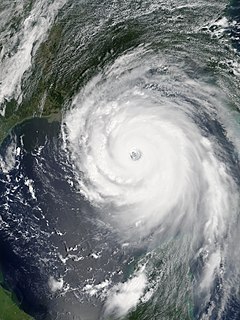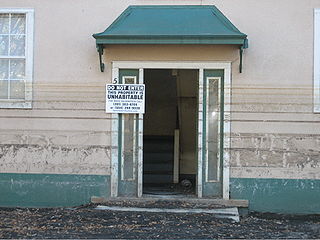
The Federal Emergency Management Agency (FEMA) is an agency of the United States Department of Homeland Security (DHS), initially created under President Jimmy Carter by Presidential Reorganization Plan No. 3 of 1978 and implemented by two Executive Orders on April 1, 1979. The agency's primary purpose is to coordinate the response to a disaster that has occurred in the United States and that overwhelms the resources of local and state authorities. The governor of the state in which the disaster occurs must declare a state of emergency and formally request from the President that FEMA and the federal government respond to the disaster. The only exception to the state's gubernatorial declaration requirement occurs when an emergency or disaster takes place on federal property or to a federal asset—for example, the 1995 bombing of the Alfred P. Murrah Federal Building in Oklahoma City, Oklahoma, or the Space Shuttle Columbia in the 2003 return-flight disaster.

Grand Isle is a town in Jefferson Parish, Louisiana, United States, located on a barrier island of the same name in the Gulf of Mexico. The island is at the mouth of Barataria Bay where it meets the gulf. As of the 2010 census, the town's resident population was 1,296, down from 1,541 in 2000; during summers, the population, including tourists and seasonal residents, sometimes increases to over 20,000. Grand Isle is statistically part of the New Orleans−Metairie−Kenner Metropolitan Statistical Area, though it is not connected to New Orleans' continuous urbanized area.

Richard Hugh Baker is an American politician and lobbyist. He served as a member of the United States House of Representatives from 1987 to 2008, representing the 6th District of Louisiana as a Republican.

Charles Joseph Melançon is an American politician and the former secretary of the Louisiana Department of Wildlife and Fisheries.

National Civilian Community Corps (NCCC), or AmeriCorps NCCC is an AmeriCorps program that engages 18- to 24-year-olds in team-based national and community service in the United States. Under the CARES act, however, the maximum age of entry is 26. National Civilian Community Corps teams complete about four different six- to eight-week-long projects during their 10-month term of service. Each team is made up of eight to twelve Corps Members and one Team Leader. Corps Members and Team Leaders are representative of all colors, creeds, states, and economic status. Approximately 1,200 Corps Members and Team Leaders are chosen annually to serve at one of four regional campuses, located in Sacramento, California; Denver, Colorado; Vinton, Iowa; and Vicksburg, Mississippi. Each campus serves as a training center and hub for a multi-state region. Members are required to complete a minimum of 1,700 hours of service, including 80 independent service hours, though members complete an average of 1,850 service hours per term.

Hurricane Katrina was a large Category 5 Atlantic hurricane that caused over 1,800 deaths and $125 billion in damage in August 2005, particularly in the city of New Orleans and the surrounding areas. It was at the time the costliest tropical cyclone on record and is now tied with 2017's Hurricane Harvey. The storm was the twelfth tropical cyclone, the fifth hurricane, and the third major hurricane of the 2005 Atlantic hurricane season, as well as the fourth-most intense Atlantic hurricane on record to make landfall in the contiguous United States.

Hurricane preparedness in New Orleans has been an issue since the city's early settlement because of its location.

The disaster recovery response to Hurricane Katrina included federal government agencies such as the Federal Emergency Management Agency (FEMA), the United States Coast Guard (USCG), state and local-level agencies, federal and National Guard soldiers, non-governmental organizations, charities, and private individuals. Tens of thousands of volunteers and troops responded or were deployed to the disaster; most in the affected area but also throughout the U.S. at shelters set up in at least 19 states.

Hurricane Katrina's winds and storm surge reached the Mississippi coastline on the morning of August 29, 2005. beginning a two-day path of destruction through central Mississippi; by 10 a.m. CDT on August 29, 2005, the eye of Katrina began traveling up the entire state, only slowing from hurricane-force winds at Meridian near 7 p.m. and entering Tennessee as a tropical storm. Many coastal towns of Mississippi had already been obliterated, in a single night. Hurricane-force winds reached coastal Mississippi by 2 a.m. and lasted over 17 hours, spawning 11 tornadoes and a 28-foot storm surge flooding 6–12 miles (10–19 km) inland. Many, unable to evacuate, survived by climbing to attics or rooftops, or swimming to higher buildings and trees. The worst property damage from Katrina occurred in coastal Mississippi, where all towns flooded over 90% in hours, and waves destroyed many historic buildings, with others gutted to the 3rd story. Afterward, 238 people died in Mississippi, and all counties in Mississippi were declared disaster areas, 49 for full federal assistance. Regulations were changed later for emergency centers and casinos. The emergency command centers were moved higher because all 3 coastal centers flooded at 30 ft (9 m) above sea level. Casinos were allowed on land rather than limited to floating casino barges as in 2005.

The reconstruction of New Orleans refers to the rebuilding process endured by the city of New Orleans after Hurricane Katrina destroyed much of the city on August 29, 2005. The storm caused levees to fail, releasing tens of billions of gallons of water. The levee failure contributed to extensive flooding in the New Orleans area and surrounding parishes. About 80% of all structures in Orleans Parish sustained water damage. Over 204,000 homes were damaged or destroyed, and more than 800,000 citizens displaced — the greatest displacement in the United States since the Dust Bowl of the 1930s. Wind damage was less severe than predicted. The damage that took place that needed to be repaired cost about $125 billion.

This article contains a historical timeline of the events of Hurricane Katrina on August 23–30, 2005 and its aftermath.

Hurricane Katrina struck the United States in August 2005, causing over a thousand deaths and extreme property damage, particularly in New Orleans. The incident affected numerous areas of governance, including disaster preparedness and environmental policy.

Hurricane Rita was the most intense tropical cyclone on record in the Gulf of Mexico and the fourth-most intense Atlantic hurricane ever recorded. Part of the record-breaking 2005 Atlantic hurricane season, which included three of the top ten most intense Atlantic hurricanes ever recorded, Rita was the seventeenth named storm, tenth hurricane, and fifth major hurricane of the 2005 season. It was also the earliest until Tropical Storm Rene in 2020. Rita formed near The Bahamas from a tropical wave on September 18, 2005 that originally developed off the coast of West Africa. It moved westward, and after passing through the Florida Straits, Rita entered an environment of abnormally warm waters. Moving west-northwest, it rapidly intensified to reach peak winds of 180 mph (285 km/h), achieving Category 5 status on September 21. However, it weakened to a Category 3 hurricane before making landfall in Johnson's Bayou, Louisiana, between Sabine Pass, Texas and Holly Beach, Louisiana, with winds of 115 mph (185 km/h). Rapidly weakening over land, Rita degenerated into a large low-pressure area over the lower Mississippi Valley by September 26th.

SBP is a nonprofit, disaster relief organization. After temporarily volunteering in St. Bernard Parish, Louisiana after Hurricane Katrina, Liz McCartney and Zack Rosenburg returned permanently in March 2006 and founded the project. The organization eventually expanded to include offices in Baton Rouge, Louisiana, Joplin, Missouri, Columbia, South Carolina, New Jersey, New York, and West Virginia. By August 2017, SBP had rebuilt over 1,200 homes nationwide, including 600 in New Orleans. They have collaborated extensively with Toyota and Americorps. As a result of its accomplishments, the organization and its founders have been recognized by Senator Mary Landrieu, CNN, and President Barack Obama.

The Water Resources Development Act of 2007 or WRDA 2007 is a United States law that reauthorized the Water Resources Development Act (WRDA), and authorized flood control, navigation, and environmental projects and studies by the United States Army Corps of Engineers. However, the law does not appropriate funds for those projects and programs. It was passed by the 110th United States Congress on November 8, 2007 over President George W. Bush's veto.
Juan Anthony LaFonta is a New Orleans personal injury attorney and former Democratic State Representative for Louisiana representing Louisiana House District 96. He was elected in 2005 during a special election and was unopposed in his 2007 re-election.

If God Is Willing and da Creek Don't Rise is a 2010 documentary film directed by Spike Lee, as a follow-up to his 2006 HBO documentary film, When the Levees Broke: A Requiem in Four Acts. The film looks into the proceeding years since Hurricane Katrina struck the New Orleans and Gulf Coast region, and also focuses on the 2010 BP oil spill in the Gulf of Mexico and its effect on the men and women who work along the shores of the gulf. Many of the participants in Levees were also featured in this documentary.
The Office of the Federal Coordinator for Gulf Coast Rebuilding was created by U.S. President George W. Bush in 2005 to devise a long-term plan for the rebuilding of the region devastated by Hurricanes Katrina and Rita. Its mission is based on a strategy focused on a set of prioritized, integrated and long-term initiatives to rebuild the region better than it was before.

Public Law 113-2, containing Division A: Disaster Relief Appropriations Act, 2013 and Division B: Sandy Recovery Improvement Act of 2013 is a U.S. appropriations bill authorizing $60 billion for disaster relief agencies. The Budget Control Act of 2011 (BCA), had authorized only disaster spending and emergency spending to exceed established spending caps. While emergency spending is not subject to the caps in the BCA, spending for disaster relief is calculated by taking the average of the previous ten years disaster relief spending, excluding the highest and lowest spending years.

Stephanie Mingo is a housing justice activist who focuses on post-Katrina New Orleans. She was born in New Orleans and raised in the St. Bernard public housing development. She works for the Orleans Parish School Board and is a mother of four. As of 2009, she lives with her family in the Iberville housing development.













